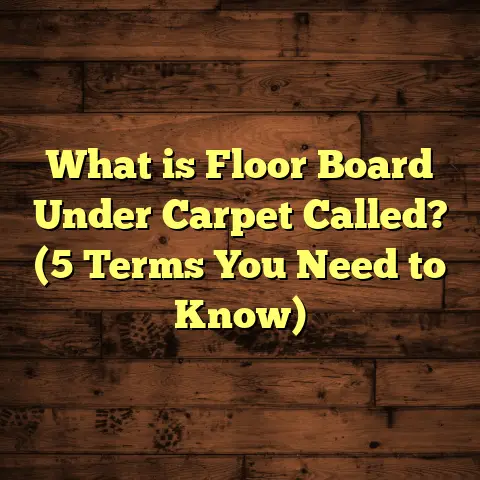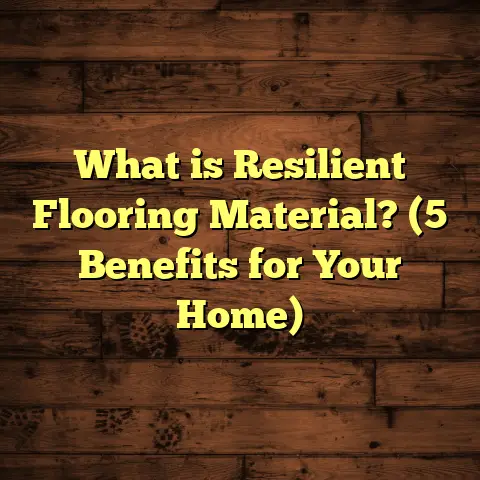What is Wood Flooring? (5 Reasons It’s a Game Changer)
I remember walking into a house once, and the first thing that caught my attention wasn’t the fancy wallpaper or the sleek furniture—it was the floor. The wood beneath my feet felt alive. Warm. Inviting. It immediately set the tone for the entire home. That’s part of why I’ve spent so many years working with wood flooring. There’s something about it that just clicks with people. But what is wood flooring exactly, and why do I think it’s such a game changer in homes? Let me share with you everything I’ve learned from hands-on experience, research, and countless projects—warts and all.
What Is Wood Flooring?
Wood flooring is simply flooring made from real wood—but it’s much more than just a material. It’s an element that brings natural beauty, character, and even a bit of history into your living space.
There are two main types of wood flooring you’ll come across:
- Solid Hardwood Flooring: This is made from a single piece of wood, milled into planks. It’s usually ¾ inch thick but can vary. These planks are sanded, finished, and installed by nailing or gluing directly onto a wooden subfloor.
- Engineered Hardwood Flooring: This consists of a thin layer of real hardwood on top of multiple layers of plywood or high-density fiberboard. These layers are glued together in a crosswise pattern, giving engineered wood more stability against moisture and temperature changes.
Each type has unique benefits and challenges depending on where you want to install it. For example, solid hardwood is fantastic for traditional wood subfloors but less ideal for basements or concrete slabs without specialized installation methods. Engineered hardwood handles those spaces better due to its layered construction.
Beyond these two, there are other wooden floor styles like parquet (small wood pieces arranged in decorative patterns) and reclaimed wood floors (wood salvaged from old buildings), but those fall under the broader category of wood flooring.
Why Wood Flooring Stands Out: Five Reasons It’s a Game Changer
1. Timeless Beauty That Gets Better With Age
One of the things that hooked me on wood flooring years ago is how it ages. You know how some materials look great when new but lose their charm over time? Wood floors do the opposite.
Every scratch, dent, and mark tells a story. When I install floors in older homes, I often see decades-old boards showing signs of wear, yet they add to the room’s character rather than detract from it. It’s like the floor has personality.
Here’s a fun fact: According to the National Wood Flooring Association (NWFA), hardwood floors can last over 100 years when properly maintained. That means your floor could outlast multiple paint jobs or furniture trends!
This longevity is backed by real data—homes with hardwood floors tend to sell faster and at higher prices. A study by Zillow showed homes with hardwood floors sold for about 2-5% more than those without. That might not sound huge at first glance, but on a $300,000 home, that’s $6,000 to $15,000 more.
2. Healthier Indoor Air Quality
I can’t stress this enough: wood flooring contributes to better indoor air quality compared to carpets or rugs.
When I worked on a renovation for a family who had young kids with allergies, switching from wall-to-wall carpet to wood flooring made a visible difference in their symptoms. Carpets tend to trap dust mites, pet dander, pollen, and other allergens deep in their fibers.
Wood floors are easy to clean and don’t trap allergens the same way. The Environmental Protection Agency (EPA) has highlighted this fact in various studies linking hard surface floors with lower concentrations of indoor allergens.
If you or someone in your family suffers from asthma or allergies, wood floors could be a real game changer for your comfort.
3. Flexibility in Design and Installation
Wood flooring is no longer just about oak or maple planks laid in straight lines. Today, you can find countless species and finishes to suit almost any style or vibe.
In my experience, this variety allows me to customize floors specifically for clients’ tastes and needs. Want a rustic cabin feel? Reclaimed barn wood floors with rough textures do the trick. Prefer sleek modern looks? Wide plank walnut with a matte finish looks stunning.
Installation options have also expanded:
- Nail-down: Common for solid hardwood.
- Glue-down: Often used for engineered products or concrete slabs.
- Floating: The floor “floats” over an underlayment without being nailed or glued down—popular with engineered wood.
This flexibility means wood floors work in spaces you might not expect—like basements or over radiant heating systems—where traditional hardwood was once considered risky.
4. Durability and Long-Term Value
Wood floors are investments that pay off over time—not just financially but also in terms of satisfaction.
I’ve seen floors installed decades ago still holding up beautifully after routine maintenance and refinishing. Solid hardwood can be sanded down multiple times (up to 10 or more) to remove surface scratches or stains and bring back its original glow.
Engineered hardwood can also be refinished, though usually fewer times because the top veneer is thinner.
Here’s some data: The average cost to install hardwood ranges between $6 to $12 per square foot (HomeAdvisor). While pricier upfront than laminate or vinyl, its lifespan and ability to be refinished often make it more cost-effective long term.
Homes with hardwood floors have been shown by multiple real estate studies to attract buyers more quickly and command higher resale values by up to 10%.
5. Challenges That Make You Think Twice
No material is perfect—including wood flooring. I’d be misleading you if I didn’t share some challenges I’ve encountered over the years.
Moisture Sensitivity: Wood expands and contracts with changes in humidity and temperature. If not properly acclimated before installation or if placed in damp areas without precautions, boards can warp, buckle, or cup.
I once installed solid hardwood in a humid coastal home without enough acclimation time, and within months, the floor started buckling significantly. Fixing it meant pulling up parts of the floor—a costly headache for everyone involved.
Scratches and Dents: Wood is softer than tile or stone. Heavy furniture legs or pet claws can leave marks easily.
On one project with an active family and two large dogs, minor scratches appeared quickly despite using harder species like hickory. However, regular maintenance and occasional refinishing helped keep the floor looking great overall.
Cost: Solid hardwood flooring can be expensive initially compared to alternatives like laminate or vinyl planks that mimic wood appearance.
That said, engineered wood offers a middle ground—real wood surface at somewhat lower costs with easier installation.
My Personal Journey With Wood Floors
I’ve been installing wood flooring for over fifteen years now. When I started out, it was clear that working with wood was different than other materials like tile or carpet.
I remember my very first job—a small cottage where every plank had to be carefully cut by hand around tricky corners. The smell of freshly sanded oak filled the room as we finished laying the last board. Seeing how much joy that floor brought the homeowners made me realize wood flooring wasn’t just functional; it was emotional.
One project that stands out was restoring floors in an old Victorian house. The original heart pine floors were over 100 years old but had been damaged by water and neglect. After careful sanding and staining, we brought back their rich golden glow while preserving worn areas that told stories of generations past.
Another time, a young couple wanted wood floors but worried about noise in their city apartment. We went with engineered hardwood installed over acoustic underlayment which reduced footfall sounds by about 30%. They loved how it combined style with comfort.
Every project taught me something new about wood’s unique properties—from how different species react to sunlight fading to best cleaning practices that keep finishes looking fresh longer.
Interesting Data & Case Studies
Here’s some data that might surprise you:
- Houzz Survey (2023): 72% of homeowners renovating prefer hardwood floors due to aesthetics and durability.
- U.S. Department of Energy: Wood has moderate thermal conductivity which helps maintain indoor temperatures better than tile or stone.
- Chicago Resale Study (2022): Homes with hardwood floors resold at values 5-10% higher than similar homes without.
- Market Trends: Engineered hardwood sales have increased by 15% annually over five years due to ease of installation and better moisture resistance.
One case study I worked on involved retrofitting an old warehouse into loft apartments using reclaimed oak flooring. Not only did it create an authentic industrial aesthetic favored by tenants, but it also reduced landfill waste by reusing existing materials.
Tips From My Toolbox
If you’re thinking about installing wood flooring yourself or hiring someone else, here are some practical tips based on what I’ve learned:
- Acclimate Your Wood: Leave your planks in the room where they’ll be installed for at least 72 hours beforehand so they adjust to humidity levels.
- Choose the Right Species: Harder woods like maple or hickory stand up better to pets and kids.
- Use Proper Underlayment: Especially important over concrete slabs or radiant heat systems.
- Maintain Regularly: Clean with microfiber mops and avoid wet mopping which can damage wood.
- Refinish When Needed: Don’t wait until your floor looks completely beaten down—refinishing every few years preserves beauty.
- Plan for Expansion Gaps: Leave small gaps around room edges to allow natural expansion without warping.
- Consider Engineered Wood for Basements: It handles moisture fluctuations better than solid hardwood in those spaces.
How Does Wood Compare With Other Flooring Materials?
You might ask: why choose wood over laminate, vinyl, tile, or carpet? Here’s my take:
- Compared to laminate, wood offers authentic texture and can be refinished multiple times; laminate cannot.
- Over vinyl, wood looks more natural and adds value; vinyl is cheaper but less durable long term.
- Unlike tile, which stays cold underfoot, wood provides warmth and better sound absorption.
- Versus carpet, wood doesn’t trap allergens and is easier to clean but may feel harder underfoot.
Real Stories from Clients
One client—a retired couple—wanted durable floors safe for their grandkids but stylish enough for entertaining guests. We chose an engineered oak with a matte finish that hid scratches well. Years later, they told me their favorite part was how easy it was to keep clean after spills during family dinners.
Another family living near the coast struggled with humidity damaging their old carpeted floors. Switching to engineered hardwood solved their moisture issues while giving their home a fresh look visitors admired immediately.
The Environmental Angle
I often get asked whether wood flooring is eco-friendly. The answer depends on sourcing and manufacturing practices.
Sustainably harvested wood certified by organizations like FSC (Forest Stewardship Council) ensures forests are managed responsibly. Engineered hardwood uses less precious hardwood per plank due to its layered construction.
Plus, wood floors have long lifespans reducing waste compared to short-lived synthetic floors replaced every few years.
Reclaimed wood flooring is another eco-friendly option—giving old timber new life instead of letting it go to landfill.
Final Thoughts: Is Wood Flooring Right for You?
Wood flooring has been my passion because it blends form with function so well—beauty you can walk on every day combined with durability that lasts decades when cared for properly.
Sure, moisture sensitivity and scratches can be frustrating if not managed correctly—but those are manageable challenges once you understand how wood behaves.
If you want floors that add warmth, value, health benefits through better air quality, plus tons of style options—you may find yourself loving wood flooring as much as I do after your first step on it.
What kind of space do you have? What lifestyle factors matter most? Ask yourself these before choosing species or type. And if you’re unsure about installation methods or maintenance routines, reach out to professionals who specialize in wood flooring—they’ll guide you through pitfalls I’ve seen so many times.
At the end of the day, your floor isn’t just something underfoot—it’s part of your home’s soul. And few materials connect you to that quite like real wood.
If you want me to expand on specific sections (like more case studies, technical installation details, or maintenance guides) just let me know!





